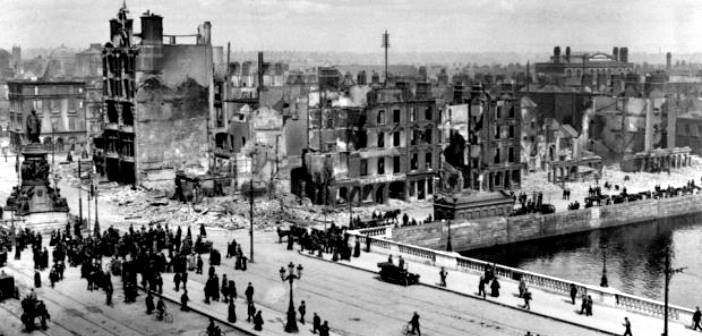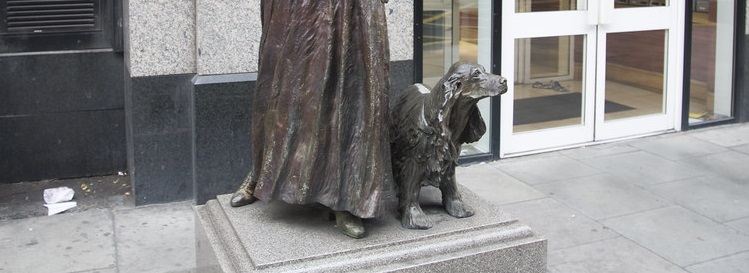Revolutionary Rover | Pets of the 1916 Rising
Easter Week 1916 saw many cats and dogs across Dublin run in fear of the chaos resulting in a significant number of homes across the capital having lost pets in the aftermath of the Rising. One pet who stubbornly stayed in his home was the dog of Michael Mallin who led the Irish Citizen Army garrison at St Stephens Green with Countess Markievicz.
When the Rising ended Mallin was one of the leaders sentenced to death. On May 5th as he and 20 other prisoners were being marched from Richmond Barracks to Kilmainham Gaol, he passed by his home in Inchicore en route to the place of his death.
In a final letter to his wife from Kilmainham, Mallin wrote:
“Only one of my household that I could cast my longing eyes on was poor Prinnie the dog, she looked so faithful there at the door.”
Mallin wrote how he longed to call out to the family pet but “was afraid to cry out to it, incase they would shoot it.”
Thomas Clarke, one of the seven signatories of the proclamation, had a particular affection for dogs and in the years before the Easter Rising he wrote a letter to his young son in which he detailed a dog he had to mind his tobacconist shop in Dublin. Clarke wrote that the “big black dog with a bushy tail” was named Kruger because “he does not like the English!” The Clarke dog was named after Paul Kruger, the Afrikaner leader who rebelled against the British in the Boer War.

Clarke wrote to his son with tales of how the dog was being trained to not only guard the shop but also tend to customers who came in to buy tobacco or newspapers. Clarke wrote,
“He is a great dog and always wants to carry a parcel in this mouth when he is going out.”
When Eamonn De Valera led the rebels in the taking of Boland’s Mills he noticed that a nearby cat and dog shelter had been abandoned by its owner’s. Dev, who cast his own mind to his own pets at home, decided to liberate the dogs and cats from their cages for fear they might succumb to the hazards of conflict.
Dev’s crusade of animal liberation didn’t end there. When the fodder for the horses at the Boland’s Mills stables had run out by mid Easter week and none could be found, he ordered them to be released.
Equine matters also came to the fore at Jacobs Biscuit Factory where Thomas MacDonagh was the commander. When he was informed that horses in a nearby stable had been cut off due to the barricades erected by the rebels, he ordered men to tend to the horses with fodder and water every day. It proved a dangerous task as they came under sniper attack from a British soldier placed in a nearby building. Jacobs factory was the only garrison in Dublin that saw the least amount of action over the course of Easter week and years later some of the rebels that were there recalled that the most dangerous manoeuvres they carried out there was the daily feeding of the horses.
Waterfowl in St Stephens Green also had to be tended to and thanks to the groundskeeper of the Green they managed to survive Easter week. James Kearney was furious that rebels had taken over his beloved Green on Easter Monday but he came to an agreement between them and the British army that they would hold a daily truce at lunch time so he could tend to the ducks in the pond. Every day Kearney would arrive with a bucket of crusts in one hand and a white flag in the other and proceeded to feed the ducks. In the aftermath of the Easter Rising James Kearney was awarded a medal of honour from the RSPCA.
Perhaps the most famous animal of that revolutionary-era was the canine companion of Countess Markievicz, a cocker spaniel called Poppet.

Today on Townsend St in Dublin stands a bronze statue of the Countess with her dog but the feisty little cocker spaniel wasn’t loved by all.
One story has it that Poppet almost destroyed the famous ‘Irish Republic’ flag that flew over the GPO during Easter week. In the days before the Rising an emerald green bedspread was used to make the famous flag in the Markievicz abode at Surrey house in Dublin. As it was spread across the grand piano in the front room for the words to be painted on it, Poppet arrived on the scene and decided to take a bite out of it.
The cocker spaniel fell foul of many a Fianna boy scout who often felt the teeth of the snappy dog on their behind. In his biography of Countess Markievicz, Sean O’ Faolain wrote that Poppet was “disliked immensely and regarded only as an old dog you’d love to root, and behind her back Poppet did get an occasional root!”
Poppet appears in many photos with the Countess as well as boys from the Fianna and her stepson Stanislas. When she was in prison after the Rising, Countess Markievicz often entertained her fellow prisoners with stories about her canine comrade who would bark and growl at the sight of a soldier in British uniform but stand to attention for the Irish Volunteers and Citizen Army.
When the Countess was released in 1917 she was reunited with her beloved dog but her political life would see her arrested once again and in 1918 after a raid on her home, she was taken to a nearby barracks but so too was Poppet. When the authorities realised the farcical situation they were in they decided to release the dog into the care of the Countess’s sister Eva, but under armed escort no less.
For all her rebellious actions Countess Markievicz did obey at least one law in 1916. In the month before the Easter Rising she dutifully renewed her dog licence.
